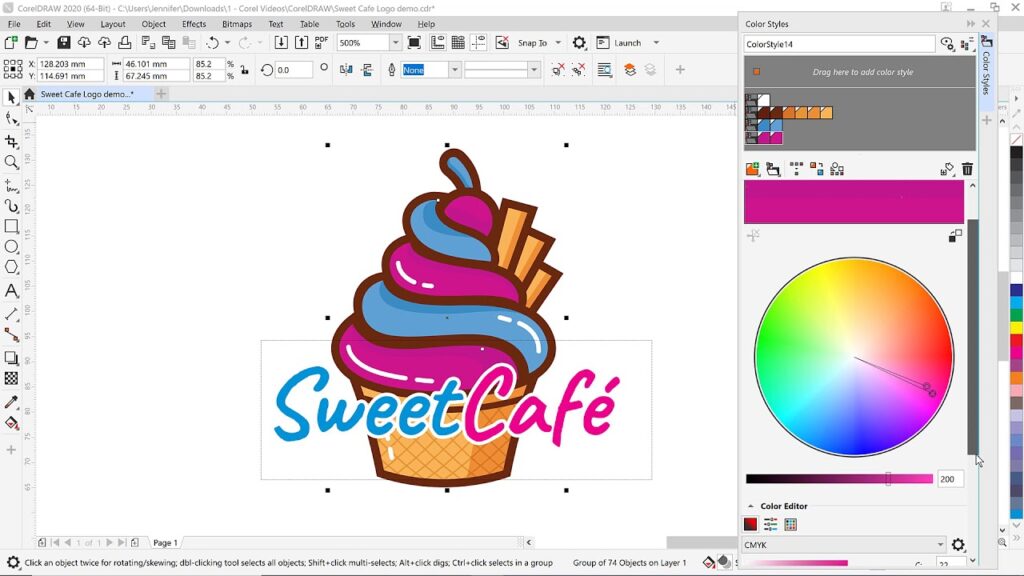Harmonizing Hues: A Comprehensive Guide to Creating Color Styles and Harmonies from Selected Objects in CorelDRAW

Introduction:
Color is a vital component in graphic design, evoking emotions, establishing identity, and enhancing visual appeal. CorelDRAW, a leading vector graphics editor, empowers designers to create harmonious color schemes with precision. This extensive guide delves into the intricacies of creating color styles and harmonies from selected objects in CorelDRAW, exploring the significance of color harmony, step-by-step instructions for the creation process, and advanced techniques for unleashing the full potential of this feature.
Section 1: The Essence of Color Harmony
1.1 Understanding Color Harmony: Color harmony involves the artful arrangement of colors to create visually pleasing and balanced compositions. Delve into the importance of color harmony in graphic design, where well-chosen color schemes enhance aesthetics and convey intended messages.
1.2 The Impact of Harmonious Color Schemes: Explore how harmonious color schemes contribute to the overall impact of a design. From creating a cohesive brand identity to evoking specific moods, understanding and implementing color harmony elevates the visual storytelling in graphic projects.
Section 2: Navigating CorelDRAW’s Color Styling Options
2.1 Exploring CorelDRAW’s Color Styles: Familiarize yourself with the Color Styles docker, a central tool in CorelDRAW for managing color styles. Understand its features, including the ability to create, edit, and apply color styles seamlessly.
2.2 Understanding Color Harmonies: Recognize the concept of color harmonies, which involve the strategic combination of colors based on their relationships on the color wheel. CorelDRAW provides features for creating harmonious color schemes effortlessly.
Section 3: Step-by-Step Guide to Creating Color Styles and Harmonies
3.1 Selecting the Reference Object: Begin the process by selecting the object from which you want to derive a color style or harmony. This object serves as the reference point for defining your color scheme.
3.2 Accessing the Color Styles Docker: Navigate to the Color Styles docker within CorelDRAW. Understand its layout and functionality, which includes options for managing existing color styles, creating new ones, and exploring color harmonies.
3.3 Creating a New Color Style: Initiate the creation of a new color style. Explore the options within the Color Styles docker to capture the color attributes of the selected object and save them as a new color style.
3.4 Naming the Color Style: Assign a meaningful and descriptive name to the newly created color style. A clear name helps identify the style’s purpose and facilitates easy selection when applying color schemes to other elements in your design.
3.5 Exploring Color Harmony Options: If you intend to create a color harmony, delve into the color harmony options provided by CorelDRAW. Choose from various harmony types, such as complementary, analogous, triadic, or custom, to tailor the color scheme to your design objectives.
3.6 Confirming the Creation of Color Style or Harmony: Finalize the creation of the color style or harmony. Confirm your selections and choices, ensuring that the defined color attributes accurately represent the reference object and desired visual effect.
Section 4: Applying Color Styles and Harmonies to Objects
4.1 Selecting Target Objects: Explore the process of applying color styles and harmonies to other objects in your design. Choose the target objects that you want to enhance with the color attributes of the created style or harmony.
4.2 Accessing the Color Styles Docker for Application: Navigate back to the Color Styles docker. Learn how to access the created color style or harmony and apply it to the selected objects, instantly imparting the chosen color scheme to your design elements.
4.3 Fine-Tuning Color Applications: Understand how to fine-tune the application of color styles and harmonies. CorelDRAW allows for flexibility in adjusting the intensity, saturation, or proportions of specific colors, providing nuanced control over your design’s visual impact.
Section 5: Advanced Techniques for Color Customization
5.1 Modifying Color Styles and Harmonies: Delve into the advanced features of modifying existing color styles and harmonies. Learn how to make adjustments to the color attributes stored in a style, accommodating changes in design requirements or evolving preferences.
5.2 Creating Variations of Color Styles: Explore techniques for creating variations of color styles and harmonies. This advanced approach involves tweaking certain attributes while preserving the core color elements, providing versatility in design application.
Section 6: Troubleshooting and Tips for Effective Color Management
6.1 Addressing Color Consistency Challenges: Understand how to troubleshoot color consistency challenges when applying styles and harmonies across different projects or versions of CorelDRAW. Explore tips for ensuring seamless color integration.
6.2 Managing Color Style Libraries: Learn effective strategies for managing your color style libraries. From organizing color styles to creating backups, efficient management ensures a streamlined workflow and easy access to the color schemes you need.
Section 7: Collaborative Workflows and Color Harmony
7.1 Sharing Color Styles and Harmonies: In a collaborative design environment, explore the methods for sharing color styles and harmonies with team members. Learn how to export and import styles to maintain consistency across projects.
7.2 Establishing Color Harmony Guidelines: Enhance collaborative workflows by establishing guidelines for color harmony. Communicate best practices and conventions to ensure a unified approach to color styling across the design team.
Conclusion:
In conclusion, the ability to create color styles and harmonies from selected objects in CorelDRAW is a potent tool for designers seeking to establish and maintain visually appealing and balanced color schemes. Whether you are a seasoned professional or a newcomer to the world of graphic design, this comprehensive guide equips you with the knowledge and techniques needed to harness the power of color styling. By understanding the importance of color harmony, navigating CorelDRAW’s color styling options, following a step-by-step guide for creating color styles and harmonies, applying them to other objects, exploring advanced customization techniques, and implementing effective troubleshooting and collaborative workflows, designers can unlock the full potential of CorelDRAW’s color styling features for a visually striking and harmonious design experience.




